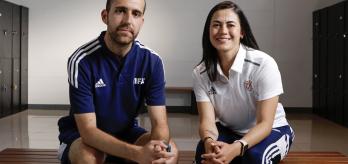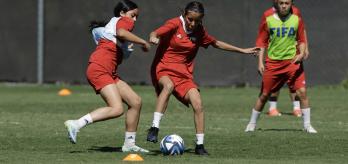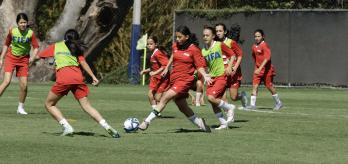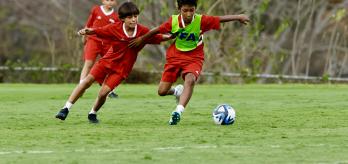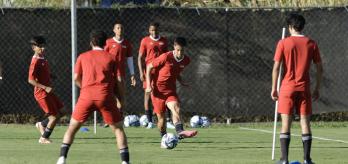When a team set up in a diamond shape from their goal kick, it can help players to create passing lanes across various lines, promoting better ball progression and enabling the team to overcome the opposition’s press.
In this session, Costa Rican Football Association Talent Coach Manfred Schumann delivers a series of exercises that aim for a group of boys to understand the principles of building from the back using a diamond shape. The session begins with a diamond passing circuit that works on passing angles and player positioning. The second drill is a 6v4 possession game that focuses on progressing play in a diamond shape. This is followed by a 6v6 plus 6 possession game that features team elements, and the session ends with a 11v9 game that incorporates all of the principles worked on in the previous exercises.
Session overview
Key coaching points
- Players should form a diamond shape around the ball carrier to create multiple passing angles.
- Adopting an open body shape before receiving the ball allows players to offer multiple passing options and to move in the direction in which they wish to travel.
- Firm and incisive passes are required to play through the press effectively.
- After playing a pass, players should always look to move into space or open up passing angles.
Part 1: Diamond passing circuit
This passing circuit works on player-scale aspects and seeks for players to become familiar with passing in a diamond shape. The exercise activates the players’ passing and movement actions in an unopposed scenario before opposed exercises are introduced later in the session.
-
Arrange 4 poles in a diamond shape, with 15m between each pole.
-
Place a cone 2m behind and in line with the poles at the head and base of the diamond.
-
Place a cone 5m behind and in line with the poles on each side of the diamond.
-
Place a cone at the midpoint of the diamond.
-
Position 2 or 3 players at each of the cones outside of the diamond.
-
Position one player at the cone at the midpoint of the diamond.
-
A passes to B, who takes a touch before passing to C.
-
C takes a touch before passing the ball out to D.
-
D continues the circuit by passing to the player at the next cone in an anticlockwise direction.
-
When the ball comes around to B again, they pass the ball into C.
-
Players are allowed two touches: one to control the ball and one to play the pass.
-
Players rotate positions by following their pass.
-
The circuit is performed in a clockwise direction. When the ball reaches D, they play a pass into C, who plays a pass out to A.
-
Players should perform the circuit at high intensity, making short, sharp movements.
-
Players should pull a few metres wide of the cone before receiving the ball.
-
Taking a firm first touch in the direction that the pass is going to be played helps to maintain the fluidity of the circuit.
-
Before receiving the ball, players should open their body up towards the direction in which they intend to play to ensure that they are able to complete the action in 2 touches.
-
Players should play firm passes to keep the tempo of the circuit high.
Part 2: 4v4 plus 4 possession game
This possession game focuses on the unit-level aspects of building and progressing play using a diamond structure. Players should look to create multiple passing angles and open the pitch up by setting up in a diamond, which gives the ball carrier options to play through the opposition.
-
Mark out a 10m x 20m exercise area.
-
Split the players into 3 groups of 4 (blues, oranges and greys).
-
Set up a 4v4 (blues v. oranges) inside the exercise area.
-
Arrange the 4 grey players, who act as neutrals, as follows: 2 players inside the exercise area and 2 players on opposite sides of the exercise area.
-
The in-possession team try to keep the ball and progress through the opposition with the support of the 4 neutral players.
-
The out-of-possession team try to win the ball.
-
The out-of-possession team cannot press the neutral players on the outside of the exercise area.
-
If the out-of-possession team gain possession, the teams swap roles immediately.
-
Given that the in-possession team comprises 8 players, they should be able to create multiple diamond shapes to retain possession.
-
Players should create passing angles by occupying the spaces between opposition players and offering to receive.
-
Players positioned further away from the ball should look to occupy a space that offers the next ball carrier a passing option.
-
Adopting an open, side-on body shape ensures that players are ready to receive the ball at all times and to play out of pressure.
-
Playing a disguised pass between 2 pressing players can eliminate them and give the receiving player more time on the ball.
Part 3: 6v6 plus 6 possession game
This possession game works on a team scale and involves players progressing the ball through pressure by forming diamond structures around the ball. The game simulates phases of play in which a team are tasked with breaking a pressing line to launch an attack or to create a goalscoring opportunity.
-
Mark out a 25m x 15m exercise area.
-
Divide the exercise area into quarters.
-
Split the players into 3 groups of 6 (blues, oranges and greys).
-
Set up a 6v6 inside the exercise area (blues v. oranges).
-
Arrange the 6 grey players, who act as neutrals, as follows: 2 players inside the exercise area and 1 player on each of its 4 sides.
-
The in-possession team look to build play and progress the ball.
-
The neutral players support the in-possession team.
-
The out-of-possession team try to win the ball.
-
If the out-of-possession team gain possession, the teams swap roles immediately.
-
Players should adopt an open, side-on body shape at all times to allow them to evade pressure or to play into space.
-
If one of the 4 zones is congested, the ball carrier should switch play so that the pressing team disperse, and gaps are created to play through.
-
If under heavy pressure and it is not possible to pass through the press, players should play a long pass to open up spaces.
-
Firm and incisive passes, along with intelligent off-the-ball movement, make it easier to play through pressure.
-
Players on the in-possession team should form diamond shapes around the ball carrier.
Part 4: 11v9 team game
This team game focuses on the team scale and works on creating goalscoring chances using quick interchanges in a specific team structure.
-
Mark out a 60m x 50m exercise area.
-
Place a full-size goal at either end of the exercise area.
-
Position a goalkeeper in each goal.
-
Split the players into 2 teams: 10 on the orange team and 8 on the blue team.
-
Play starts and restarts with the goalkeeper of the team with the numerical advantage.
-
The in-possession team try to build up play and score.
-
The out-of-possession team try to win the ball by staying compact and closing off passing lanes.
-
The in-possession team must use the full width of the exercise area.
-
A 11v11 is contested in a larger exercise area.
-
Play starts and restarts from the goalkeeper at either end of the exercise area.
-
Players should create passing angles by forming diamond structures around the ball carrier.
-
If areas become congested, players should look to switch play quickly to the wide players.
-
When playing through central areas, players should ensure that there is support both behind and beyond the receiving player.
-
Incisive firm passes played between defenders can break the opposition’s defensive structure.





